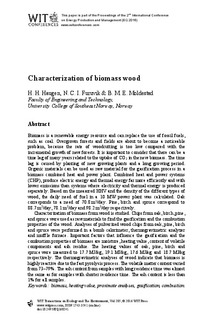| dc.description.abstract | Biomass is a renewable energy resource and can replace the use of fossil fuels, such as coal. Overgrown forests and fields are about to become a noticeable problem, because the rate of woodcutting is too low compared with the incremental growth of new forests. It is important to consider that there can be a time lag of many years related to the uptake of CO2 in the new biomass. The time lag is caused by planting of new growing plants and a long growing period. Organic materials can be used as raw material for the gasification process in a biomass combined heat and power plant. Combined heat and power systems (CHP), produce electric energy and thermal energy far more efficiently and with lower emissions than systems where electricity and thermal energy is produced separately. Based on the measured HHV and the density of the different types of wood, the daily need of fuel in a 10 MW power plant was calculated. Oak corresponds to a need of 70.8 m3/day. Pine, birch and spruce correspond to 88.7 m3/day, 78.1 m3/day and 98.2 m3/day respectively. Characterization of biomass from wood is studied. Chips from oak, birch, pine, and spruce were used as raw materials to find the gasification and the combustion properties of the wood. Analyses of pulverized wood chips from oak, pine, birch and spruce were performed in a bomb calorimeter, thermogravimetric analyzer and muffle furnace. Important factors that influence the gasification and the combustion properties of biomass are moisture, heating value, content of volatile components and ash residue. The heating values of oak, pine, birch and spruce were measured to 17.7 MJ/kg, 19.1 MJ/kg, 17.6 MJ/kg and 18.7 MJ/kg respectively. The thermogravimetric analyses of wood indicate that biomass is highly reactive due to the fast pyrolysis process. The volatile matter content varied from 73??9%. The ash content from samples with long residence time was almost the same as for samples with shorter residence time. The ash content is less than 1% for all samples. | |
